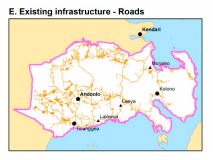A socio-ecological approach to GIS least-cost modelling for regional mining infrastructure planning: a case study from South-East Sulawesi, Indonesia.
Regional planning approaches to mining infrastructure aim to reduce the conflict associated with mining operations and existing land uses, such as urban areas and biodiversity conservation, as well as the cumulative impacts that occur offsite. In this paper, we describe a method for conducting Geographical Information System (GIS) least-cost path and least-cost corridor analysis for linear mining infrastructure, such as roads. Least-cost path analysis identifies the optimal pathways between two locations as a function of the cost of traveling through different land use/cover types. In a case study from South-East Sulawesi, Indonesia, we identify potential linear networks for road infrastructure connecting mines, smelters, and ports. The method used interview data from government officials to characterise their orientation (perceived importance and positive/negative attitude) toward the social and environmental factors associated with mining infrastructure. A cost-surface was constructed by integrating spatial layers representing the social and environmental factors to identify areas that should be avoided and areas that were compatible with linear infrastructure using the least-cost path analysis. We compared infrastructure scenario outputs from local and national government officials by the degree of spatial overlap and found broad spatial agreement for infrastructure corridors. We conclude by discussing this approach in relation to the wider social-ecological and mine planning literature and how quantitative approaches can reduce the conflict associated with infrastructure planning.
Publisher: Resources
Region: Global
Type: Article

